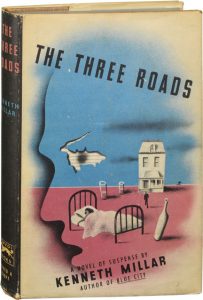THE THREE ROADS
Part One
APPROACHING THE THREE ROADS
YOU CAN’T GET THERE FROM HERE
The Three Roads is probably the most bewildering, complicated, ambitious novel Macdonald ever completed. Essentially, it attempted to use the myth of Oedipus as the basis for a contemporary mystery. It was an audacious experiment for a relatively inexperienced writer working against a deadline, both in terms of structure and theme. More so than the first three books, it gives us an in-depth look at the themes that will dominate his mature work.
Before I can even relate what commentators have said, this book requires a preliminary blog post.
SOME CONTEXT
Macdonald had recently been discharged from the Navy and had joined his wife, Margaret Millar and their daughter in Santa Barbara, which would become their home for the rest of their lives.
- The Three Roads was not only the first of his books to be written in California but was the first to have a California setting (in this case, San Diego and Los Angeles rather than the fictionalized Santa Barbara of many of the later books.)
- It is his only novel that Macdonald did not consider as a mystery. His own description was “psychothriller,” although he also referred to it as a “psychiatric mystery.” The book is deeply indebted to the thriller conventions employed by Margaret Millar in her own suspense novels.
- This is the only time he used the third person point of view.
- It represents his first attempt to deal with the human condition from a psychiatric standpoint. The plot contains psychological explanations and speculations from two different psychiatrists, neither of whom is in any hurry to make their points.
- It’s a long book for the genre, over 75,000 words. And this is after the manuscript was shortened by 10,000 words at the insistence of his publisher, Alfred Knopf.
- Because of objections from Knopf, Macdonald was required to spend three months on rewrites. For the first time, the published version of one of his books reflected strong editorial input and authorial revision. I will backtrack a little on what I’ve said about the importance of revision. The cuts and rewrites improved the pace, but at a cost. The role of some of the minor characters is puzzling because evidently they had more to do in chapters that were left on the cutting room floor.
- For the first time Macdonald uses his academic background in a way that’s organic to the story. The title is a reference to the myth of Oedipus, who kills the king of Thebes at a place where three roads meet. Then he marries the queen and becomes king himself. Later, when it becomes necessary to find the killer of the former king, he finds out that the killer he has been looking for is himself. The plot of The Three Roads is the hero’s search for the killer of his wife . . . So to the knowledgeable, this is one of the few novels of suspense where the title itself is a spoiler.
THE BOOK IS A HOT MESS
There, I’ve said it.
As we will see in my next post, the academicians differ sharply about the book. But the main disagreement is what is wrong with it.
DON’T LET THAT STOP YOU
The Three Roads, for all its flaws, is important in tracing his development—more so than the three the preceded it. This is his first step towards the tricky business of character-driven fiction. And he takes on the added burden of fitting his story within the tangled plot of the Oedipus story. The fact that he succeeds imperfectly doesn’t mean that it doesn’t deserve examination. As Pauline Kael said of the movie, New York, New York, this book is “an honest failure.”
So, armed with some background, let’s move on to the scholarly response.

Recent Comments